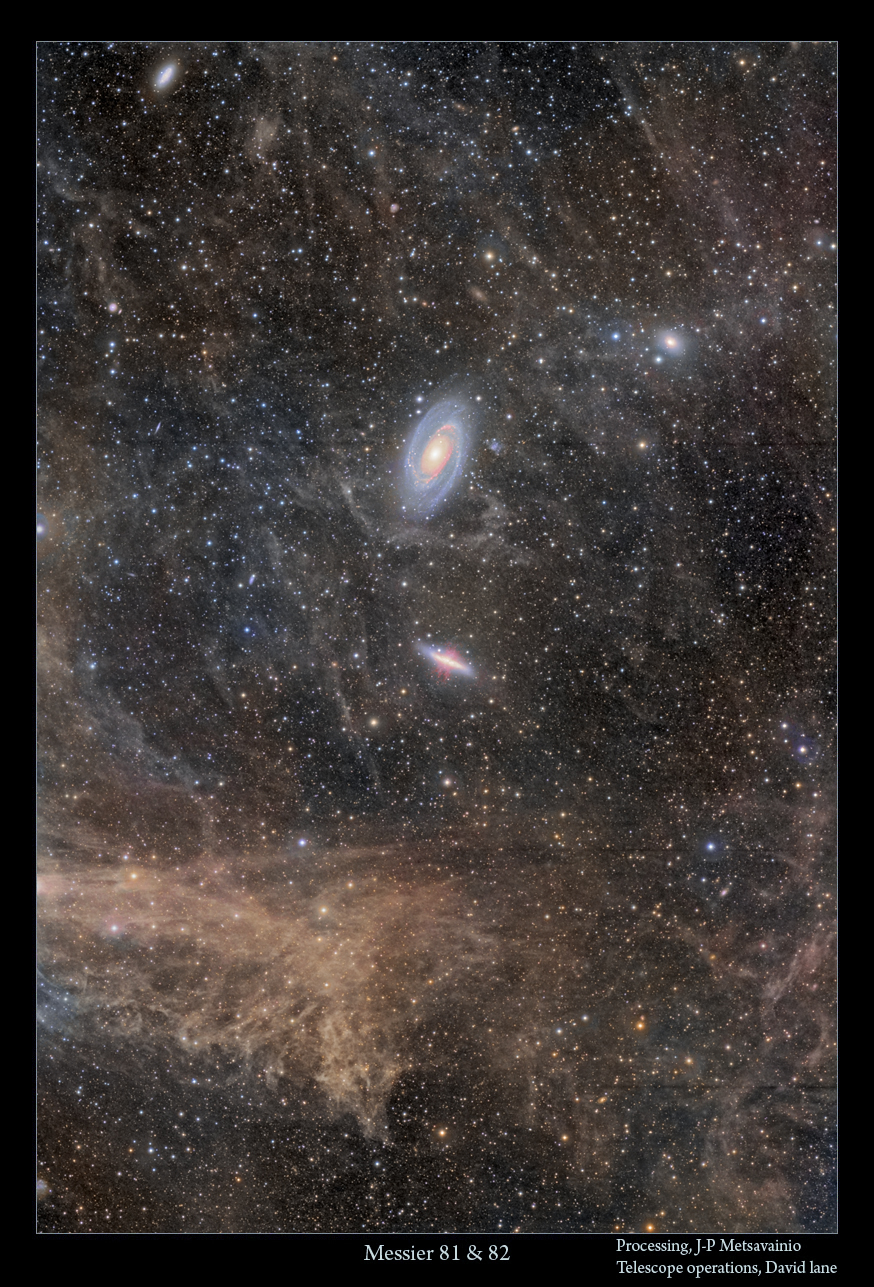COPYRIGHT, PLEASE NOTE
All the material on this website is copyrighted to J-P Metsavainio, if not otherwise stated. Any content on this website may not be reproduced without the author’s permission.
BUY A MUSEUM QUALITY POSTER
BUY A POSTER:https://astroanarchy.zenfolio.com/
Sunday, October 4, 2015
Barnard 72, the Snake Nebula
A new image produced as a collaboration with me and Eric Recurt. The data is shot from his observatory at Tenerife. The Observatory locates at 2400 m altitude and at 28 degrees North. The site has excellent seeing conditions, 0.8 " on average and can be below 0.3 "
Barnard 72
You better click the image to see it in full glory! (2100 x 1600 pixels, 6,5MB)
The Snake Nebula, Barnard 72, lays at front of a very dense starfield of our Milky Way
A full resolution closeup, click for a large image
INFO
The Snake Nebula (also known as Barnard 72) is a dark nebula in the Ophiuchus constellation at a distance of about 650 light years. Barnard 72 lays at front of the Milky Way star clouds from the north-north-west edge of the bowl of the Pipe Nebula.
Technical details
Processing workflow
Deconvolution with a CCDStack2 Positive Constraint, 23 iterations, added at 33% weight
Color combine in PS CS3
Levels and curves in PS CS3.
Imaging optics
340mm F3.3 astrograph
Mount
ASA DDM 85
Cameras and filters
FLI PL 16803
Exposure times
Luminance, 40 min.
Red = 15 min.
Green = 15 min.
Blue = 15 min.
Total 1h 25min
Labels:
nebula
Thursday, October 1, 2015
A new image, the Witch's Broom Nebula
This is my second photo for this season from my observatory. It's a detail of the veil nebula supernova remnant, as was my first light photo for this Autumn season, the Pickering's Triangle. This is a two frames mosaic image, exposed on several nights between September 10. - 27. 2015. Total exposure time is about 11h.
NGC 6960, the Witch's Broom Nebula
Click for a large image, 2200 x 1500 pixels and 2,3MBA two frame mosaic of the Veil Nebula supernova remnant, the Witch's Broom Nebula in mapped colors. Colors are from the emission of the ionized elements, Hydrogen, Sulfur and Oxygen.
S-II = Red, H-alpha = Green and O-III = Blue.
Close up images
Click for a large image
A starless image
Click for a large image
An experimental starless version to show the structure of the filaments better.
Visual colors
Click for a large image
Natural color composition from the emission of ionized elements.
This composition is very close to a visual spectrum.
Witch's broom in light of an ionized oxygen only
Click for a large image
This image shows the Witch's Broom in Light of an ionized oxygen, O-III, alone.
A wide field photo of the Veil Nebula supernova remnant
The Witch's Broom Nebula can be see at three o'clock position.
My blog post about this older wide field shot can be seen HERE.
Technical details
Processing work flow
Image acquisition, MaxiDL v5.07.
Stacked and calibrated in CCDStack2.
Deconvolution with a CCDStack2 Positive Constraint, 21 iterations, added at 25% weight
Color combine in PS CS3
Levels and curves in PS CS3.
Imaging optics
Celestron Edge HD 1100 @ f7 with 0,7 focal reducer for Edge HD 1100 telescope
Mount
10-micron 1000
Cameras and filters
Imaging camera Apogee Alta U16 and Apogee seven slot filter wheel
Guider camera, Lodestar x2 and SXV-AOL
Astrodon filter, 5nm H-alpha
Astrodon filter, 3nm O-III
Astrodon filter, 3nm S-II
Exposure times
H-alpha, 15 x 1200s = 5h
O-III, 36 x 1200s binned = 5h (Autumn 2014)
S-II, from my older wide field photo of the Veil Nebula = 1h
Total 11h
Labels:
Narrowband color images,
nebula
Friday, September 25, 2015
Astro Anarchy gets published
The Cnet published an article about Messier 31, the Great galaxy of Andromeda, photo.
Photo of Messier 31 is produced by collaboration between David Lane and me.
You can read the Cnet article by Michelle Starr from
The Wired noticed us too
Ten must-read articles for 25 September
Our photo is number five on the list
Labels:
publications
Thursday, September 24, 2015
Messier galaxies, M81-M82, with integrated flux nebula
A new collaboration image with David Lane. Beside beeing a deep sky astrophotographer he is also a master of landscape astrophotographing, please, have a look at his homepage: http://www.davelaneastrophotography.com/
Image acquisition is made by David Lane. He sent a massive amount of data to me to process and here is the result, Messier galaxies 81 and 82 with a large amount of dim integrated flux nebula at front of them.
Total exposure time is around 40 hours with the William Optics GT81 telescope and SBIG STL-1100 3 CCD-camera.
Total exposure time is around 40 hours with the William Optics GT81 telescope and SBIG STL-1100 3 CCD-camera.
Messier 81 and 82 with an integrated flux nebula
Click for a large photo
So dusty, don't they ever clean up there...
An experimental starless photo
Click for a large photo
Brighter dots in this starless image are more distant galaxies
A horizontal composition
Click for a large photo
A better resolution photo
Technical details
Data acquisition, David Lane
Image processing, J-P Metsavainio
Processing workflow
Deconvolution with a CCDStack2 Positive Constraint, 27 iterations, added at 33% weight
Color combine in PS CS3
Levels and curves in PS CS3.
Imaging optics
William Optics GT81
Camera
SBIG STL-1100 3 CCD
Exposure times
Total ~40h
Labels:
galaxy images
Subscribe to:
Comments (Atom)
























